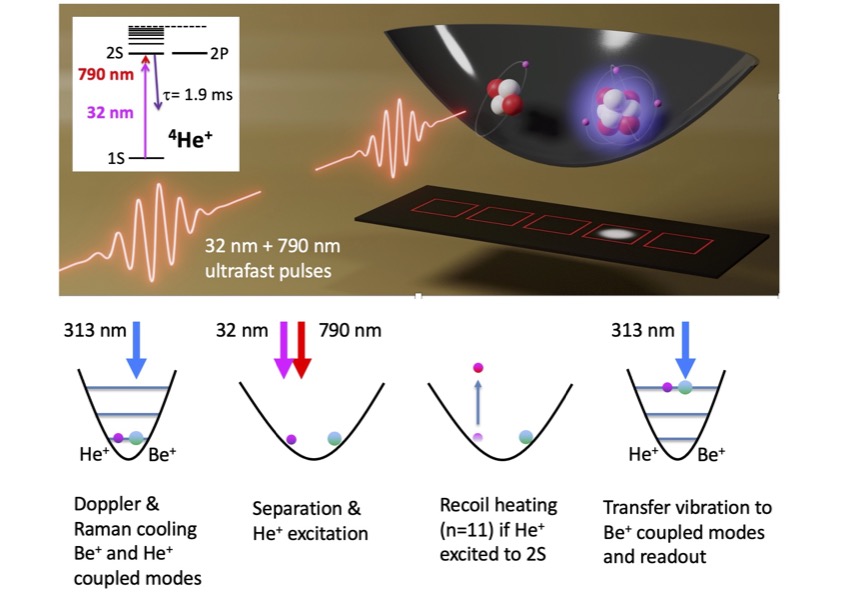
 |
|
 |
12 JUNE 2025: THIS WEBSITE WILL BE REPLACED SOON BY A MORE MODERN ONE
Jobs: NEW PhD positions available (since June
2025)
|
|
|
Position: 1 PhD position (4 years) on 1S-2S spectroscopy of trapped He+ for fundamental tests, and 1 PhD position for precision spectroscopy of quantum-degenerate (ultracold) helium to probe the nuclear size difference between the alpha and helion particle. Both positions are part of a new NWO ENW-M2 grant (June 2025)
See the link below to watch a video explaining the He+ experiment, presented by Elmer Gründeman (PhD student), filmed by Vincent Barbé (Postdoc), and edited by Andrés Matinez de Velasco (PhD student):
https://youtu.be/bPmsekrWzlw
The first PhD position is available at the experiment where we want to excite the 1S-2S transition in a single He+ ion. The aim is to measure the 1S-2S transition precisely (<10 kHz). He+ is a calculable system, similar to hydrogen, but with the big advantage that it can be trapped in a Paul trap, and that Quantum Electrodynamical (QED) effects are an order of magnitude bigger than in hydrogen. So precision measurements in He+ would open up a new testing ground for QED, but also will enable us to verify the fundamental Rydberg constant and determine the charge radius of the nucleus: the alpha particle. This is done by comparing the results with other determinations, e.g. in atomic hydrogen, muonic hydrogen, and muonic helium+. The overall aim is to test the standard model at the atomic scale, and potentially find new physics.
The second PhD position is available on excitation of a double-forbidden transition in both 3He and 4He, trapped and cooled to quantum degeneracy (a degenerate Fermi gas for 3He and a Bose condensate for 4He). By looking at the spectroscopic difference (the isotope shift) we can extract the best charge radius difference of the respective nuclei, the helion particle and the alpha particle. More details on this position will follow soon.
The remainder of this page gives more details on the He+ experiment.
For the He+ experiment there a two main challenges. The first is the wavelength required to excite He+ from the 1S state: extreme ultraviolet. Secondly, the question is how to detect the 1S-2S transition. Excitation will be performed by a two-photon transition combining 32 nm and 790 nm. The 32 nm is produced by high-harmonic generation with ultrafast and powerful pulses from an amplified frequency comb laser.
Recently we have been able to excite the He+ 1S-2S transition with 790 nm + 32 nm in ions produced in an atomic beam, which is a great step forward, and shows that our concept of excitation works!:
E.L. Gründeman, V. Barbé, Andrés Martinez de Velasco, C. Roth, M. Collombon, J.J. Krauth, L.S. Dreissen, R. Taïeb, K.S.E. Eikema
Laser excitation of the 1S-2S transition in singly-ionized helium
Communications Physics 7, 414 (2024)
https://www.nature.com/articles/s42005-024-01891-4
The next step is a precision measurement, and for that we will employ Ramsey-comb spectroscopy, which was developed in our group. Detection will initially be based on double-ionization. However, this will destroy the ion, so that a new one has to be loaded, which takes time. Instead, we want to develop quantum-logic methods in which we read out the He+ state by the motion of the Be+ cooling ion that is co-trapped, see the picture below.

The whole experiment involves many techniques, such as a frequency comb laser, high-power parametric laser pulse amplification, an ultra-stable laser, laser cooling at 313 nm, side-band cooling, ultra-high vacuum, quantum-optics, high-harmonic generation, and so much more! We have quite unconventional ideas how to realize the first excitation of He+ from the ground state and detection of the transition. The target accuracy is 10 kHz or better on the transition.
You can read more about the He+ experiment here.
Below: the High-Harmonic Generation and excitation setup for He+ spectroscopy (in a configuration for a precursor experiment with Xe).
The setup has been converted now to excite He+, and are currently working on driving the 1S-2S in He+ produced by XUV ionization of He in a beam.
Applicants for PhD position 1 (He+) or PhD position 2 (neutral helium):
You should have a MSc or engineering degree in physics or something comparable, and have affinity with lasers and electronics. Most important is that you are bright, enthusiastic, work well in a team, fluent in English, are eager to learn, and of course that you are enthusiastic about these intriguing projects!
General conditions of employment
You can find information about the side benefits at www.workingatvu.nl.
The project and positions are based in the LaserLaB Vrije Universiteit Amsterdam: http://www.vu.nl/en/index.asp
The Vrije Universiteit Amsterdam is a leading, innovative and growing university that is at the heart of society and actively contributes to new developments in teaching and research. Our university has ten faculties which span a wide range of disciplines, as well as several institutes, foundations, research centers, and support services. Its campus is located in the fastest-growing economic region in the Netherlands (the Zuidas district of Amsterdam), and provides work for over 4,500 staff and scientific education for more than 23,000 students.
Evaluations take place continuously, but as long as this message is visible, the position is still open.
Send your application to prof. dr. Kjeld Eikema, email: k.s.e.eikema@vu.nl.
Please include a letter of motivation, CV, and 2 names with email addresses of people as a reference.
